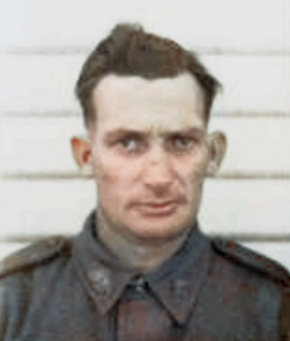
CABLE, Henry James
| Service Number: | VX27275 |
|---|---|
| Enlisted: | 15 June 1940, Caulfield, Victoria. |
| Last Rank: | Private |
| Last Unit: | 2nd/21st Infantry Battalion |
| Born: | Harnham, Wiltshire, England , 2 November 1901 |
| Home Town: | Colac, Colac-Otway, Victoria |
| Schooling: | Not yet discovered |
| Occupation: | Labourer |
| Died: | Presumed to be dead, Ambon, Netherlands East Indies, 20 February 1942, aged 40 years |
| Cemetery: |
No known grave - "Known Unto God" Commemorated ~ Column 3, Ambon Memorial, Ambon, Kota Ambon, Maluku, Indonesia. |
| Memorials: | Ambon Memorial, Australian War Memorial Roll of Honour, Ballarat Australian Ex-Prisoners of War Memorial |
World War 2 Service
| 3 Sep 1939: | Involvement Private, VX27275 | |
|---|---|---|
| 15 Jun 1940: | Enlisted VX27275, Recruit Reception Depot, Caulfield, Victoria. | |
| 15 Jun 1940: | Enlisted Australian Military Forces (WW2) , Private, VX27275 | |
| 7 Jul 1940: | Transferred Private, 2nd/21st Infantry Battalion, Seymour, Victoria, from 15th Infantry Training Battalion. | |
| 13 Dec 1941: | Embarked Private, VX27275, 2nd/21st Infantry Battalion, Darwin. Disembarked Ambon 17-12-1941. | |
| 2 Feb 1942: | Imprisoned Ambon, Missing 2-2-1942. Missing, believed deceased, Laha Garrison, “on or after 7-2-42.” For official purposes Presumed Dead 20-2-1942. Date coincides with the “5th massacre” of Australian soldiers at Laha airfield. |
Help us honour Henry James Cable's service by contributing information, stories, and images so that they can be preserved for future generations.
Add my storyBiography contributed by Karen Standen
Henry James Cable was the eldest son of Henry Edward and Rosina Cable (née Chalk). Born in the Salisbury suburb of Harnham, Henry was their second child. The family moved to the small Wiltshire village of Swallowcliffe, when ‘Harry’, as he was more commonly known, was a boy.
It was here at the parish church, that Harry’s eldest sister, Hilda married an Australian soldier, Sergeant Clair Larson (/explore/people/208708), in August 1919. The following year, the couple sailed for Australia aboard the Bahia Castillo. Arriving in Melbourne in May, Clair and his bride continued on to his family's property at Carlisle River, near Colac in Victoria.
At nineteen years of age, Henry followed his sister. Arriving on the Themistocles in August 1921, Harry was employed as a farm labourer. He worked in several Victorian farming districts, including Gippsland and Flinders, before eventually settling closer to Hilda.
Enlisting in the 2nd A.I.F. in June 1940, Harry initially gave his sister as his next of kin. This changed however in January 1941, when Harry married his sweetheart, Ivy May Bartlett. Their time together was short, as the 2/21st were transferred to Darwin three months later and at the end of 1941, they embarked for Ambon as part of Gull Force.
In late January 1942, Japanese forces arrived at Ambon. Outnumbered by almost 20 to 1, the Australian and Dutch forces were overwhelmed. It is presumed Harry was one of more than 300 prisoners massacred by the Japanese at the Laha airfield during February 1942.
Like so many other families of soldiers with no known grave, for Ivy and Harry’s family, it was not knowing what had actually happened to him, that was the hardest thing to bear. Ivy never remarried. She passed away in April 2000.
Biography contributed by Stephen Bonald
Private Henry James Cable (VX27275) was a member of the 2nd/21st Australian Infantry Battalion which formed part of “Gull Force”.
This force consisted of 1131 Australian soldiers, Dutch and local native troops whose objective was to occupy Ambon Island, which is located approximately 350 miles North Northeast of Timor in the Banda Sea and hinder the Japanese advance Private Henry James Cable was a member of the large garrison, positioned around Laha Airfield prior to the Japanese invasion of 30 January 1942.
After a series of short but fierce battles, fighting on Ambon Island ceased on 2 February 1942. Although many of those captured on other parts of the island survived the war. The troops who had survived the “Battle of Laha” (approximately 315 personnel) were systematically executed and buried in one of four mass graves.
Investigations after the war determined it was impossible to positively identify many of the remains found at Laha. Therefore these ‘war dead’ were declared “Become missing and for Official Purposes Presumed to be Dead, 20 February 1942”. Unfortunately, and sadly Private Henry James Cable was one of these servicemen to which the fortune of war, has denied a formal burial given to his comrades in death."
“Not one life can we call lost, for with it will be riven, the sacred memory of a life, unto his country given." -















